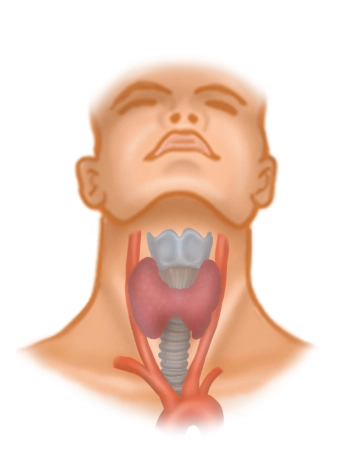Situated between the anterior margin of the sternocleidomastoid muscle, the mandibula and the jugular fossa, the anterior cervical triangle near the hyoid bone comprises the suprahyoid and subhyoid muscles, vessels, nerves and the thyroid. The only important subhyoid muscles in thyroid surgery are the medial
- sternohyoid muscle (sternum → hyoid bone) which covers the
- sternothyroid muscle (sternum → thyroid cartilage of the larynx) and more laterally the
- omohyoid muscle (scapula → intermediate tendon→ hyoid bone)
because they partly cover the thyroid gland and must be retracted laterally.
Blood vessels
Before dividing into the internal and external carotid artery, its two main branches, at the superior margin of the thyroid cartilage at the level of its carotid sinus (pressoreceptors for the blood pressure and chemoreceptors for the blood gases), the carotid artery courses in the carotid sheath immediately lateral to the trachea and esophagus. Here, it touches the left and right thyroid lobe as a major blood vessel. The internal jugular vein arises from the sigmoid sinus in the skull, collects the blood from the head and neck, and while coursing caudad it first accompanies the internal carotid artery in the carotid sheath before pursuing a more lateral course, enclosing the lateral aspects of the common carotid artery and vagus nerve (CN X).
Nerves
The ansa cervicalis (superior and inferior roots, from C1-C3), which innervates these three above muscles of the anterior triangle of the neck, and the transverse nerve of the neck (from C2/3, innervation of skin and platysma) courses cephalocaudad lateral to the thyroid and next to the vagus nerve and its superior branch to the larynx (superior laryngeal nerve → anterior cricothyroid muscle and mucosa of the superior laryngeal half).
Fascial layers
The skin of the anterior triangle of the neck covers several fascial layers (all belonging to the cervical fascia) with distinctive features:
- The superficial lamina invests all structures of the neck, except for the platysma, and separately invests the sternocleidomastoid muscle as well as the posterior aspect of the trapezius muscle (accessory nerve XI),
- with the medial pretracheal lamina investing the infrahyoid muscles and
- the deep prevertebral lamina coursing outside the surgical field between the esophagus and spine.
Just like the lateral vascular and nerve pedicle (carotid artery, internal jugular vein and vagus nerve), the trachea and thyroid / parathyroids also have their own organ fascias. With their three-dimensional configuration, the fascias invest compartments interspersed with spaces which extend into the mediastinum and thus represent potential routes of infection.

